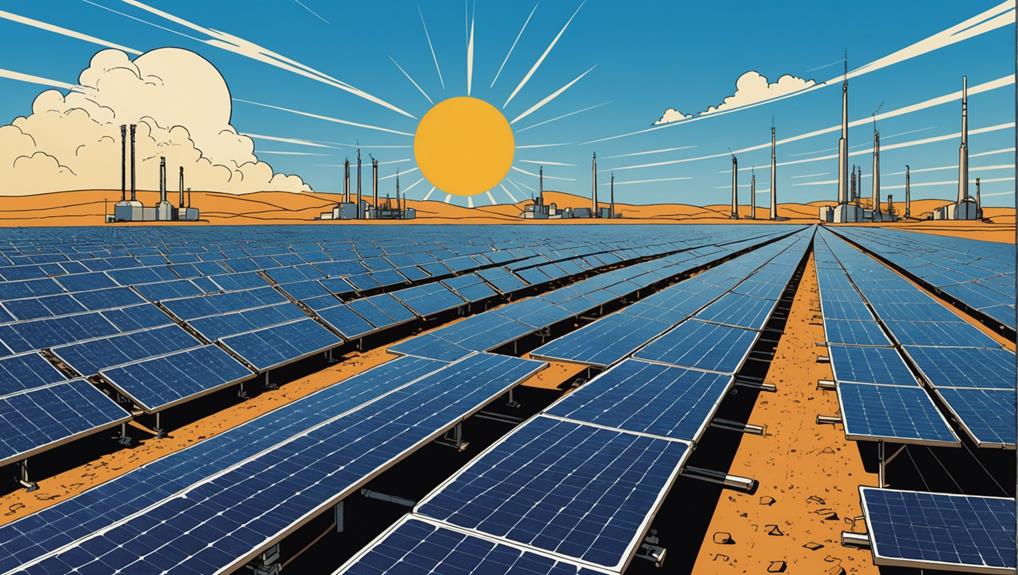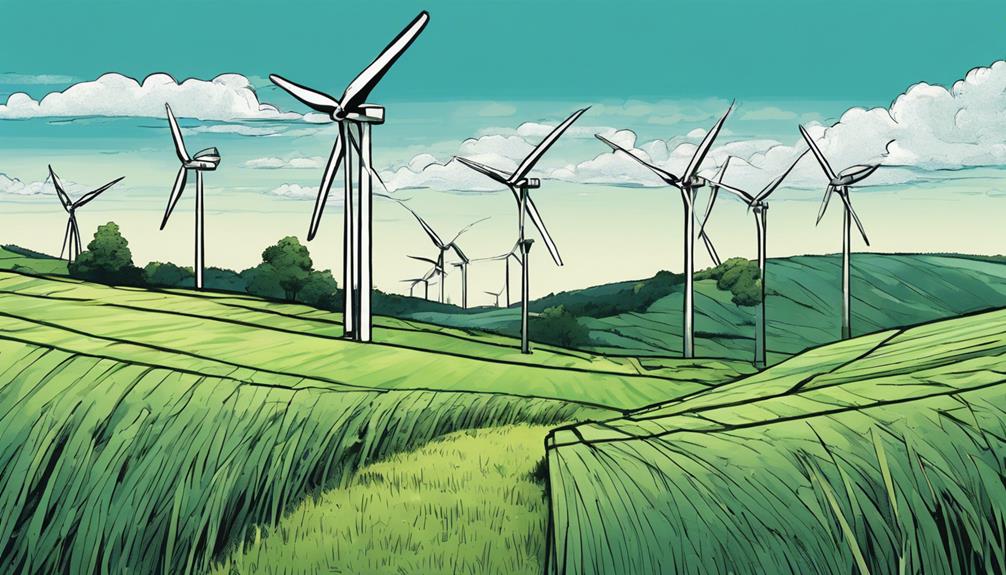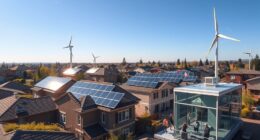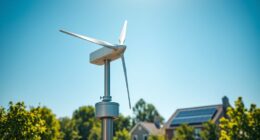The relationship between solar energy and latitude impacts how much sunlight a specific area on Earth receives. Areas near the equator get more direct and intense sunlight, while places closer to the poles receive sunlight at lower angles. The angle of sunlight incidence affects the intensity of solar energy across different latitudes. If you want to understand how latitude influences solar energy distribution in more detail, keep exploring the various factors at play.
Key Takeaways
- Solar energy reception decreases as latitude increases.
- Equatorial areas receive more concentrated solar energy.
- Angle of sunlight incidence varies with latitude.
- Higher latitudes experience lower angles of sunlight.
- Latitude influences the intensity and availability of solar energy.
Factors Influencing Solar Energy Reception
The angle of incidence of the sun's rays significantly influences the reception of solar energy, varying with latitude. This means that areas closer to the equator receive more direct and intense sunlight, resulting in higher solar energy received compared to regions closer to the poles.
As the Earth's curvature causes the sun's rays to hit the surface at different angles depending on the latitude, the amount of solar energy reaching a specific area changes. Equatorial regions experience a more perpendicular angle of incidence, leading to concentrated solar energy, while polar regions receive sunlight at a shallower angle, spreading the same amount of energy over a larger area.
Understanding this relationship between the angle of incidence and solar energy received is pivotal for predicting temperature variations and climate patterns across different latitudes. By comprehending how solar energy distribution changes with latitude, scientists and researchers can better assess energy availability and optimize solar power systems for specific geographic locations.
Solar Constant and Insolation

Considering the solar constant and insolation in relation to solar energy reception, it's vital to understand how these factors influence the amount of solar energy reaching the Earth's surface.
The solar constant, at approximately 1368W/m2, indicates the energy the Earth receives from the Sun at its outer atmosphere. This value serves as a reference point for understanding solar energy distribution. Factors such as sunspots, which follow an 11-year cycle, can cause fluctuations in the solar constant, impacting the amount of solar energy reaching our planet.
The angle of incidence of the sun's rays also plays an essential role in determining the intensity of solar energy received at different latitudes, affecting the overall insolation levels.
Moreover, Earth's elliptical orbit leads to variations in its distance from the Sun, directly influencing the amount of solar energy received.
Additionally, the transparency of the atmosphere affects insolation levels by determining how much solar energy reaches the Earth's surface.
Impact of Angle of Incidence

When the sun's rays hit the Earth at different angles, it influences how solar energy is distributed across latitudes.
Higher angles lead to a more concentrated energy delivery, while lower angles spread the energy out.
Understanding the impact of the angle of incidence is important in comprehending how solar energy varies geographically.
Sun Angle Influence
With the angle of incidence playing a pivotal role in determining solar energy distribution, it impacts the amount of solar energy received at different latitudes on Earth. The angle at which sunlight hits the Earth's surface influences the concentration of energy received. Areas closer to the equator receive sunlight more directly, resulting in more concentrated solar energy. In contrast, regions at higher latitudes receive sunlight at a lower angle, causing the energy to be spread over a larger surface area. This difference in angle of incidence affects the intensity of solar energy received, with vertical rays delivering more concentrated energy compared to slanted rays. Additionally, the angle of incidence influences the path sunlight takes through the atmosphere, impacting the amount of energy that reaches the Earth's surface. The table below illustrates how the angle of incidence affects solar energy distribution:
| Angle of Incidence | Energy Received | Impact on Solar Energy Distribution |
|---|---|---|
| Vertical (0°) | High | Concentrated energy |
| Slanted (>0°) | Decreases | Energy spread over larger area |
Energy Distribution Impact
The impact of the angle of incidence on solar energy distribution becomes evident when considering how sunlight interacts with Earth's surface at varying latitudes. The angle at which the sun's rays hit the Earth affects how energy is distributed across different regions, influencing the efficiency of solar energy utilization.
Here are some key points to understand this impact:
- Higher latitudes receive sunlight at smaller angles, causing the energy to be spread out over a larger surface area.
- Vertical rays, hitting closer to a right angle, provide more concentrated energy compared to slanting rays that cover a larger area.
- As the angle of incidence increases, solar energy decreases, impacting the total energy received by a location.
- The distribution of energy varies with latitude due to the differing angles at which the sun's rays reach the Earth's surface.
Understanding the angle of incidence is vital for optimizing solar energy systems to harness maximum energy output efficiently.
Atmospheric Path Variation
At higher latitudes, the path length of solar radiation through the atmosphere increases, influencing the amount of energy reaching the surface. This extended atmospheric path results in a greater scattering and absorption of sunlight.
When sunlight enters the atmosphere at a low angle, it must traverse a longer distance, interacting with more particles and gases along the way. As a result, some of the solar energy is scattered or absorbed before it reaches the surface, diminishing the overall energy available for conversion.
The phenomenon of increased atmospheric path length at higher latitudes plays an important role in determining the actual energy absorption by the Earth's surface. Understanding this aspect is vital for optimizing solar energy collection systems in regions with varying latitudes, ensuring efficient energy harnessing despite the challenges posed by the angle of incidence and atmospheric conditions.
Influence of Day Length

Day length greatly impacts the duration of sunlight you receive, affecting solar energy availability in your region.
Closer to the equator, you experience more consistent day lengths throughout the year, while polar regions encounter extreme variations leading to substantial changes in solar energy reception.
Understanding these variations is essential for evaluating the availability of solar energy in different regions.
Day Length Impact
Considering how day length directly affects solar energy absorption, understanding its impact is essential for predicting seasonal variations in temperature and climate. Day length plays a pivotal role in determining the amount of solar energy a particular area receives.
Longer days mean more exposure to sunlight, resulting in higher solar energy absorption. This has significant implications for the temperature and climate patterns of different regions on Earth.
Areas closer to the poles experience notable fluctuations in day length throughout the year. Equatorial regions maintain a consistent day length, ensuring a steady intake of solar energy.
The variation in day length directly influences the seasonal changes in temperature. Predicting climate patterns requires a profound understanding of how day length impacts solar energy absorption.
Sunlight Duration Variation
How does the variation in day length impact the duration of sunlight exposure at different latitudes?
Day length plays a pivotal role in determining the amount of sunlight a specific region receives. As you move towards higher latitudes, the length of daylight fluctuates significantly, leading to variations in solar radiation exposure.
In summer, higher latitudes enjoy longer days, resulting in increased sunlight intake and higher solar energy availability. Conversely, regions closer to the Equator experience relatively consistent day and night lengths throughout the year. This balance in day length contributes to a steadier supply of solar radiation in equatorial areas.
On the other hand, Arctic and Antarctic regions encounter extreme fluctuations in day length, with periods of continuous daylight or darkness. These variations directly impact the availability of solar energy in these polar regions, affecting both the duration and intensity of sunlight exposure.
Earth's Distance From Sun Effects

The Earth's distance from the Sun fluctuates throughout its elliptical orbit, directly impacting the amount of solar energy received. This distance plays a pivotal role in determining the solar energy reaching our planet.
Here are some key effects of Earth's varying distance from the Sun:
- Earth's distance ranges from about 147 million km (perihelion) to 152 million km (aphelion), affecting the solar energy received.
- The Northern Hemisphere experiences a 7% difference in solar energy reception between aphelion and perihelion due to the elliptical orbit.
- Changes in Earth's distance lead to seasonal variations in solar energy reception, impacting insolation levels across different latitudes.
The transparency of Earth's atmosphere influences how much solar energy is absorbed and distributed globally. Understanding the Earth's distance from the Sun helps explain seasonal changes in solar radiation and temperature fluctuations.
Transparency of the Atmosphere

Ever wondered how the atmosphere's clarity impacts the amount of solar energy reaching Earth's surface? The atmosphere plays a significant role in determining how much solar energy actually reaches the Earth's surface. Gases such as nitrogen, oxygen, water vapor, and particulate matter in the atmosphere affect the transmission of solar energy, influencing its quality and quantity available for absorption. Different layers of the atmosphere act as filters, either allowing or blocking solar radiation from reaching the surface. The level of atmospheric clarity directly impacts how effectively sunlight is transmitted through the atmosphere to be absorbed by the Earth.
To better understand this concept, let's look at how the clarity of the atmosphere affects solar energy:
| Atmospheric Clarity | Impact on Solar Energy |
|---|---|
| High Clarity | Increased solar energy reaching the surface |
| Low Clarity | Decreased solar energy reaching the surface |
Latitude's Role in Solar Energy

Understanding the impact of latitude on solar energy distribution is vital for comprehending global energy patterns and variations in sunlight reception across different regions. When it comes to solar energy and latitude, several key factors come into play:
- Solar energy reception is highest at the equator due to the more direct angle of sunlight.
- As you move towards the poles, solar energy gets spread out over a larger area, resulting in lower energy intensity.
- Regions closer to the equator receive more concentrated solar energy compared to areas at higher latitudes.
- The angle of sunlight incidence is essential in determining the amount of solar energy received at different latitudes.
- Understanding the relationship between latitude and solar energy helps explain temperature variations across the Earth's surface.
These factors highlight the significant role that latitude plays in determining the availability and intensity of solar energy in different parts of the world.
Seasonal Variations in Solar Reception

In considering the seasonal shifts in solar reception, it becomes evident that Earth's tilt and orbit play a significant role in shaping the amount of sunlight reaching different latitudes. Seasonal variations in solar reception are intricately tied to Earth's axial tilt and orbital position.
For instance, during the winter solstice on December 21st, areas in the Northern Hemisphere receive the least solar energy as the North Pole tilts away from the sun, causing shorter days and lower temperatures. In contrast, on June 21st, the Northern Hemisphere experiences the peak of solar reception as the North Pole leans towards the sun, leading to longer days and warmer temperatures.
Latitude also influences the amount of solar energy received, with equatorial regions basking in more direct sunlight compared to polar regions. This interplay between latitude, Earth's tilt, and orbit creates distinct seasonal variations in solar reception, impacting temperature fluctuations and climate patterns worldwide.
Frequently Asked Questions
What Is the Relationship Between Latitude and Solar Energy?
Latitude directly impacts solar energy reception, affecting energy distribution across Earth's surface. As you move closer to the equator, sunlight is more concentrated, while regions near the poles receive less intense solar energy due to spreading.
What Is the Relationship Between Latitude and Solar Altitude?
As you move towards the equator from the poles, solar altitude increases. This means areas closer to the equator receive higher solar altitudes throughout the year. Conversely, at higher latitudes, solar altitudes are lower.
What Happens to Solar Energy as Latitude Increases?
As latitude increases, solar energy received decreases due to sunlight spreading out over a larger area. Areas nearer the equator get more concentrated solar energy. The angle of sunlight changes with latitude, affecting intensity.
What Is the Relationship Between Solar Energy and Earth?
When it comes to solar energy and Earth, think of it like a dance between the sun and our planet. The angle of sunlight varies by latitude, impacting temperature and energy distribution.
How Does the Relationship Between Solar Energy and Latitude Affect the Distribution of Solar Energy on Earth?
The relationship between solar energy and latitude greatly affects the distribution of solar energy on Earth. Areas closer to the equator receive more direct sunlight, while polar regions solar energy is more diffused due to the angle of the sun’s rays. This results in uneven distribution of solar energy across the globe.
Conclusion
To sum up, the relationship between solar energy and latitude greatly impacts the amount of sunlight a given area on Earth receives.
As you move closer to the equator, sunlight is more direct and intense, leading to higher levels of solar energy.
Conversely, as you move towards the poles, sunlight becomes more dispersed and less intense.
Remember, latitude serves as a key determinant in the distribution of solar energy, shaping the climate and environment of a region like a painter's brush on a canvas.










